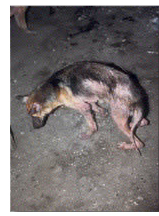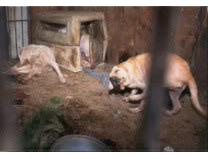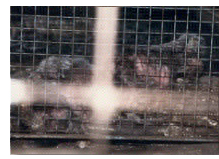|
|
|
|
|


ALIVE
All Life In a Viable Environment
5-18-10-102, Honkomagome, Bunkyo-ku, Tokyo, 113-0021
Japan
Tel.+81-3-5978-6272
Fax..+81-3-5978-6273

Anti Vivisection Action Network
|
|
 |

Rogue breeder
ALIVE News 1999
Text: Andreas Knobel, photos: Sachi Ozeki@ALIVE
Currently there is no legal system in Japan
restricting breeders, pet
shop and "zoo" owners, importers
and other professionals
dealing with animals. While breeders are licensed in England
and other countries, here anyone wanting
to make a quick yen can set up shop.
We came
across this problem breeder
on some farmland in Nishio,
a village nestled in
the hills of Aichi-ken. Some
shacks made from scrap
wood were lined up, and as we
drew closer a terrible
stench emanated from the buildings.
Neighbours
had for a long time
been complaining about this
rogue breeder,  and
on 27 October 1998
officials of the Aichi-ken Department
of Hygene decided to
investigate and entered the establishment.
What met their eye
defies description. Five to ten
dogs were kept in boxes
of two or three meters square
each. Most of the animals
were suffering terribly
from scabies, and some looked
a raw pink, having
lost all their hair to the disease.
Others again were bleeding
from rubbing their
itchy skin against the lattice
frame of their cages.
The ground was muddy with urine
and faeces. Some of
the dogs were unable to walk, weakened
by the loss of blood
or because their nails had grown too
long. and
on 27 October 1998
officials of the Aichi-ken Department
of Hygene decided to
investigate and entered the establishment.
What met their eye
defies description. Five to ten
dogs were kept in boxes
of two or three meters square
each. Most of the animals
were suffering terribly
from scabies, and some looked
a raw pink, having
lost all their hair to the disease.
Others again were bleeding
from rubbing their
itchy skin against the lattice
frame of their cages.
The ground was muddy with urine
and faeces. Some of
the dogs were unable to walk, weakened
by the loss of blood
or because their nails had grown too
long.
All of
the animals were ragged,
mere shadows of their former
selves, yet Golden Retrievers,  Maltese,
Yorkshire Terriers and other
fashionable breeds could
be made out among them. Most
of the dogs had never been
vaccinated against rabies,
an entirely unlawful situation.
The Department
of Hygene in Aichi-ken
challenged the breeder to transfer ownership
of the dogs "voluntarily" and
of 99 dogs rescued the
94 which he finally let
go.
Upon
hearing the news, volunteers
from in- and outside
the prefecture arrived,
and with
the help of the veterinary
association began the  lengthy
process of treating
the various skin diseases
and parasites.
Eight dogs died from
exhaustion, and another
sixteen who were
in particularly bad
shape had to be put
down. At first,
the remaining animals
were frightened of
the volunteers
but gradually gained
confidence, and had
a happy look on their
faces during the daily bath. lengthy
process of treating
the various skin diseases
and parasites.
Eight dogs died from
exhaustion, and another
sixteen who were
in particularly bad
shape had to be put
down. At first,
the remaining animals
were frightened of
the volunteers
but gradually gained
confidence, and had
a happy look on their
faces during the daily bath.
Finally,
on 28 November potential
foster parents from all
over the country came to Aichi-ken,
and the dogs that had
been rescued from Hell began a
new life.
Stories
that make it into the
papers are only the tip of the legendary
iceberg: most cases
never come to the public's
attention. Note that the Nishio breeder
could not be charged
with cruelty to animals, and that
the Department of Hygene
had to intervene. Only
when the situation at such establishments
becomes so extreme
that it constitutes a risk to public
health will the authorities
act.
|
 |
 |
|
|
|




![]()
 and
on 27 October 1998
officials of the Aichi-ken Department
of Hygene decided to
investigate and entered the establishment.
What met their eye
defies description. Five to ten
dogs were kept in boxes
of two or three meters square
each. Most of the animals
were suffering terribly
from scabies, and some looked
a raw pink, having
lost all their hair to the disease.
Others again were bleeding
from rubbing their
itchy skin against the lattice
frame of their cages.
The ground was muddy with urine
and faeces. Some of
the dogs were unable to walk, weakened
by the loss of blood
or because their nails had grown too
long.
and
on 27 October 1998
officials of the Aichi-ken Department
of Hygene decided to
investigate and entered the establishment.
What met their eye
defies description. Five to ten
dogs were kept in boxes
of two or three meters square
each. Most of the animals
were suffering terribly
from scabies, and some looked
a raw pink, having
lost all their hair to the disease.
Others again were bleeding
from rubbing their
itchy skin against the lattice
frame of their cages.
The ground was muddy with urine
and faeces. Some of
the dogs were unable to walk, weakened
by the loss of blood
or because their nails had grown too
long. Maltese,
Yorkshire Terriers and other
fashionable breeds could
be made out among them. Most
of the dogs had never been
vaccinated against rabies,
an entirely unlawful situation.
Maltese,
Yorkshire Terriers and other
fashionable breeds could
be made out among them. Most
of the dogs had never been
vaccinated against rabies,
an entirely unlawful situation. lengthy
process of treating
the various skin diseases
and parasites.
Eight dogs died from
exhaustion, and another
sixteen who were
in particularly bad
shape had to be put
down. At first,
the remaining animals
were frightened of
the volunteers
but gradually gained
confidence, and had
a happy look on their
faces during the daily bath.
lengthy
process of treating
the various skin diseases
and parasites.
Eight dogs died from
exhaustion, and another
sixteen who were
in particularly bad
shape had to be put
down. At first,
the remaining animals
were frightened of
the volunteers
but gradually gained
confidence, and had
a happy look on their
faces during the daily bath.